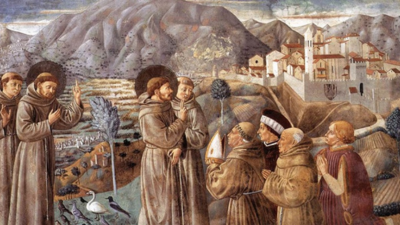The First Missions
St. Francis of Assisi
In the 1217 meeting of friars (“chapter”), it was agreed to send missions out across the Alps into northern Europe and other locals. It was the beginning of the missionary impulse.

An earlier article had discussed the problems with the rapid growth of members within the fledgling community friars. The period from 1213 to 1216 is the most obscure period in Francis’ life and also one of the periods of explosive growth in the movement as the brotherhood spread well beyond Assisi. How many friars joined the fraternity in those years? It is impossible to say, but we do know this: in 1217 the annual meeting (called a “chapter”) made the decision to send out missions across the Alps into northern Europe, the Baltic states, and to the Crusader States in the eastern Mediterranean. Within Italy, six provinces were established; outside of Italy, five provinces were established: Spain, northern and southern France, Germany, and Syria.
In the areas where the language was similar to Italian, especially Spain, the foundation of new fraternities was relatively without incident. The friars were well received. However, the men who reached Paris were suspected of heresy like the Cathars or other groups, but they were able to explain themselves well enough to the bishop and his university consulters that they were left in peace. Even then, they had to procure a confirmation of their orthodoxy from Pope Honorius.
The friars were sent out in the spirit of the Gospel, but also without linguistic preparation. The sixty brothers who went to Germany with the minister Brother John of Penna discovered that, when asked if they were hungry, saying “ja” was an excellent response. But when asked if they were Cathar heretics from Lombardy, they also answered “ja,” and the result was imprisonment, beating, and worse. In Hungary, where the language barrier was even greater, the brothers were attacked by robbers, who took their cloaks and then beat them because they had no money. They gave up their tunics, but they were beaten even worse. Finally, they sacrificed their under-trousers, but to no good effect. After begging for clothing to cover their nakedness, this group also went back to Italy. Other missionaries returned to Italy, equally frustrated and battered.
The missions, however unsuccessful, did have a telling result. Francis and his movement became both known outside of Italy and a subject of talk. By 1219 one English preacher, Odo of Cheriton, could already speak of Francis as though all his hearers knew who he was and what he was like. Odo used him as an example of someone who guilelessly spoke his mind to everyone, including popes. He also knew that Francis was fond of using parables and stories for instruction. Although he lived in England, Odo’s perception of Francis was correct.
The traveling brothers found that they were treated no better by the clergy than by the laity. For ecclesiastical authorities, the problem was that the brothers could show no rule formally approved by the pope. The papal approval in 1209 of the original form of life was provisional and probably not available in a written text. As the disheartened friars returned home, bitter and frustrated, Francis found that they did not consider passive acceptance of rejection as a virtue. Some came to him, probably at one of the Pentecost chapters, to ask that he request a papal privilege granting them access to areas where they had encountered resistance, and even the right to preach without episcopal permission. Francis reacted sternly and rebuked them for not accepting their rejection without complaint. Prelates were to be won over by the brothers’ obedience and humility, not by papal orders.
When Cardinal Hugolino (who we introduced several weeks ago) attended the chapter, probably in 1218, Francis’ stern rejection of appeals to the Roman Curia does not seem to have stopped the brothers from going behind his back and asking Hugolino for help. The cardinal got an earful from the brothers about the behavior of Church authorities. Cardinal Hugolino’s response to friars’ complaints, even if he fell short of getting a papal command that prelates were to receive the brothers, angered Francis greatly. Hugolino procured a papal letter of recommendation certifying the brothers’ orthodoxy. Nevertheless, this regularization of the movement in the Church accomplished by Hugolino gave Francis a freedom he previously lacked. Following the Pentecost chapter of 3 June 1219, Francis finally fulfilled his longtime hope to go abroad, preach Christ to unbelievers, and perhaps even to achieve martyrdom. In late June, the Francis appointed two vicars, Gregory of Naples and Matthew of Narni, who would lead the brotherhood in Francis’ name while he was away. With that accomplished, Francis and set out for the Middle East during the time of the Fifth Crusade.